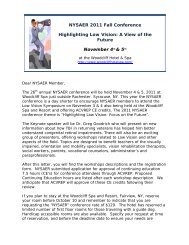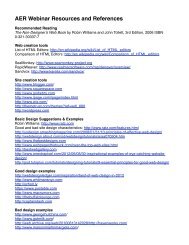Association for Education and Rehabilitation of the ... - AER Online
Association for Education and Rehabilitation of the ... - AER Online
Association for Education and Rehabilitation of the ... - AER Online
Create successful ePaper yourself
Turn your PDF publications into a flip-book with our unique Google optimized e-Paper software.
Assessing Young Children with Deaf-Blindness<br />
blind because ‘‘passing’’ many items requires intact<br />
sensory capacities. The presence <strong>of</strong> multiple<br />
disabling conditions typical <strong>of</strong> <strong>the</strong> vast majority <strong>of</strong><br />
children in this ‘‘low-incidence’’ group (Chen, 1999)<br />
renders <strong>the</strong>se tools even less appropriate. Additionally,<br />
relatively few evaluators have had training or<br />
direct experience working with young children who<br />
are deaf-blind. As a consequence <strong>of</strong> <strong>the</strong>se <strong>and</strong> o<strong>the</strong>r<br />
factors, assessments <strong>of</strong> children who are deaf-blind<br />
<strong>of</strong>ten result in <strong>the</strong> identification <strong>of</strong> weaknesses ra<strong>the</strong>r<br />
than strengths (Rowl<strong>and</strong>, 2005) <strong>and</strong> yield little<br />
in<strong>for</strong>mation relevant <strong>for</strong> educational planning.<br />
The field <strong>of</strong> early childhood special education has<br />
established recommended practices <strong>for</strong> assessing<br />
young children with disabilities (Division <strong>for</strong> Early<br />
Childhood, 2007; Neisworth & Bagnato, 2005) that<br />
underscore <strong>the</strong> most important assumptions underlying<br />
effective assessment <strong>of</strong> this population (Chen,<br />
Rowl<strong>and</strong>, Stillman, & Mar, 2009). First, underst<strong>and</strong>ing<br />
a child’s communication behaviors is prerequisite<br />
to gaining insight about his or her learning style,<br />
aptitudes, social competence, <strong>and</strong> concept knowledge.<br />
Many children who are deaf-blind use<br />
expressive communication <strong>for</strong>ms o<strong>the</strong>r than speech,<br />
including reactions (e.g., smiling, crying), directed<br />
behaviors (e.g., reaching), gestures, signs, vocalizations,<br />
<strong>and</strong> picture <strong>and</strong> object symbols (Mar & Sall,<br />
1999a; Rowl<strong>and</strong> & Schweigert, 2000, 2004). The<br />
evaluator must become familiar with <strong>the</strong> ways in<br />
which a child comprehends <strong>and</strong> signals to o<strong>the</strong>rs, not<br />
only to assess <strong>the</strong> child’s communicative competence<br />
but also to gain an underst<strong>and</strong>ing <strong>of</strong> his or her<br />
interests, knowledge, <strong>and</strong> needs. Second, assessment<br />
approaches <strong>and</strong> instruments must consider <strong>the</strong><br />
impact <strong>of</strong> sensory impairments on concept acquisition<br />
<strong>and</strong> <strong>the</strong> unique ways in which <strong>the</strong>se children<br />
acquire in<strong>for</strong>mation from <strong>the</strong> environment. Children<br />
with vision <strong>and</strong> hearing impairments may learn about<br />
everyday objects <strong>and</strong> spaces primarily through <strong>the</strong>ir<br />
tactile, kines<strong>the</strong>tic, <strong>and</strong>/or olfactory properties, in<br />
addition to (or instead <strong>of</strong>) <strong>the</strong>ir auditory <strong>and</strong> visual<br />
properties. Concepts like size, <strong>for</strong> example, might be<br />
acquired by <strong>the</strong> positioning <strong>of</strong> <strong>the</strong> arms <strong>and</strong> h<strong>and</strong>s<br />
during manipulation <strong>of</strong> objects <strong>of</strong> different sizes,<br />
instead <strong>of</strong> <strong>the</strong> objects’ visual characteristics. Concepts<br />
such as number, shape, direction, speed,<br />
height, volume, position, <strong>and</strong> color may be extrapolated<br />
from <strong>the</strong> child’s everyday h<strong>and</strong>s-on experiences,<br />
ra<strong>the</strong>r than pictures, diagrams, or verbal<br />
descriptions (Rowl<strong>and</strong> & Schweigert, 2001). Third,<br />
unlike traditional assessment, in which children are<br />
presented <strong>for</strong>mal tasks in isolated settings, assessment<br />
<strong>of</strong> children who are deaf-blind must occur <strong>and</strong><br />
be referenced to skills <strong>and</strong> behaviors in typical<br />
contexts, such as <strong>the</strong> learning <strong>and</strong> social activities<br />
that occur in classrooms, homes, <strong>and</strong> communities<br />
(Chen et al., 2009). Measures such as age<br />
equivalents, percentile rankings, <strong>and</strong> st<strong>and</strong>ard scores<br />
are valid only if <strong>the</strong> child with deaf-blindness has had<br />
<strong>the</strong> same learning opportunities as <strong>the</strong> children on<br />
whom <strong>the</strong> instrument has been normed (e.g.,<br />
typically developing peers).<br />
Despite <strong>the</strong> shortcomings <strong>of</strong> <strong>the</strong> most common<br />
st<strong>and</strong>ardized instruments, many assessment tools—<br />
both those designed <strong>for</strong> use with typical <strong>and</strong> lowincidence<br />
populations—can potentially be used to<br />
assess <strong>the</strong> communication, learning, <strong>and</strong> cognitive<br />
abilities <strong>of</strong> young children who are deaf-blind.<br />
However, <strong>the</strong>re has been no systematic ef<strong>for</strong>t to<br />
examine what instruments are being used in current<br />
practice, how widely <strong>the</strong>y are used, <strong>and</strong> to what<br />
extent <strong>the</strong>se tools are consistent with recommended<br />
early childhood practices. This study, conducted in<br />
conjunction with a research grant funded by <strong>the</strong> U.S.<br />
Department <strong>of</strong> <strong>Education</strong>, sought to examine current<br />
practices in <strong>the</strong> assessment <strong>of</strong> cognitive, communication,<br />
<strong>and</strong> learning skills <strong>of</strong> young children who are<br />
deaf-blind. Its purposes were to (a) examine <strong>the</strong> tools<br />
used by pr<strong>of</strong>essionals to assess young children (2 to<br />
8 years <strong>of</strong> age) who are deaf-blind <strong>and</strong> who have<br />
additional disabilities; (b) evaluate promising tools in<br />
terms <strong>of</strong> <strong>the</strong> constructs <strong>of</strong> appropriateness, applicability,<br />
accuracy, <strong>and</strong> usability; <strong>and</strong> (c) investigate <strong>the</strong><br />
role that assessment plays in individualized education<br />
plan (IEP) <strong>and</strong> individualized family service plan<br />
(IFSP) development. O<strong>the</strong>r data from this project,<br />
including perspectives <strong>of</strong> experts, family members,<br />
<strong>and</strong> family specialists, are reported in Chen <strong>and</strong><br />
colleagues (2009) <strong>and</strong> clinical suggestions are provided<br />
in Rowl<strong>and</strong> (2009). Complete data on <strong>the</strong> 5-year project<br />
may be found at http://www.ohsu.edu/oidd/d2l/com_pro/<br />
DeafblindAssessmentDataSummary.pdf<br />
Method<br />
64 | <strong>AER</strong> Journal:Research <strong>and</strong> Practice in Visual Impairment <strong>and</strong> Blindness<br />
Participants<br />
A total <strong>of</strong> 135 pr<strong>of</strong>essionals from 24 states,<br />
recruited with <strong>the</strong> help <strong>of</strong> <strong>the</strong> National Family<br />
<strong>Association</strong> <strong>of</strong> Deaf-Blind <strong>and</strong> <strong>the</strong> state deaf-blind







